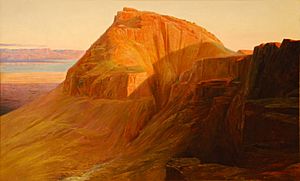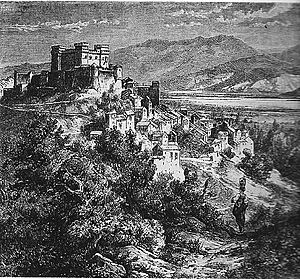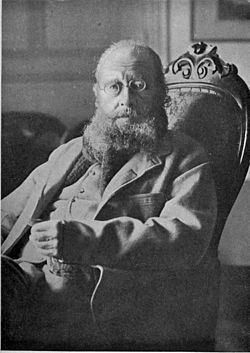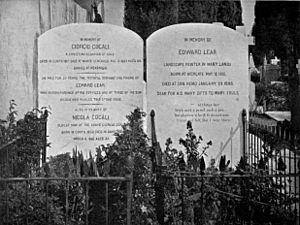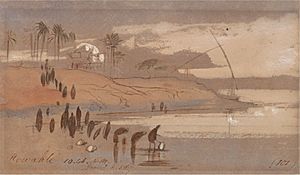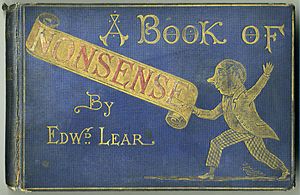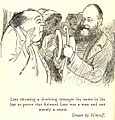Edward Lear facts for kids
Quick facts for kids
Edward Lear
|
|
|---|---|
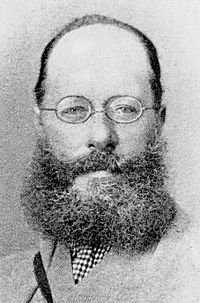
Edward Lear in 1866
|
|
| Born | 12 May 1812 Holloway, Middlesex, England |
| Died | 29 January 1888 (aged 75) Sanremo, Liguria, Italy |
| Occupation | Artist, illustrator, writer, poet and musician. |
| Language | English |
| Nationality | British |
| Citizenship | British, Italian |
| Period | 19th century |
| Genre | Children's literature, literary nonsense and limericks. |
| Notable works | The Book of Nonsense, The Owl and the Pussycat |
Edward Lear (born May 12, 1812, died January 29, 1888) was a talented English artist, illustrator, musician, author, and poet. He is best known today for his funny and imaginative "literary nonsense" works, especially his short, humorous poems called limericks. He helped make limericks very popular.
As an artist, Lear did three main things:
- He drew birds and animals for scientific books.
- He made colorful drawings during his travels, which he later turned into paintings or book illustrations.
- He also illustrated some poems by the famous poet Alfred, Lord Tennyson.
As a writer, he is famous for his popular collections of nonsense poems, songs, short stories, and even silly recipes and alphabets. He also wrote music for twelve of Tennyson's poems.
Contents
Edward Lear's Life Story
Early Years and Challenges
Edward Lear was born in Holloway, North London, into a middle-class family. He was the second to last of 21 children. His father, Jeremiah Lear, was a stockbroker. Edward was mostly raised by his oldest sister, Ann, who was 21 years older than him. When Edward was four, his family faced money problems, so he and Ann had to move out of their family home. Ann was like a mother to him and cared for him until she passed away when he was nearly 50.
Lear had health problems throughout his life. From age six, he often had epileptic seizures, a condition that made him feel ashamed. He also suffered from bronchitis and asthma. Later in life, he even lost some of his eyesight. When he was about seven, he started having periods of deep sadness, which he called "the Morbids." This might have been because his childhood was not very stable.
Becoming a Talented Artist
By the time he was 16, Lear was already drawing to earn money. He quickly became a serious artist who drew birds. He worked for the Zoological Society and then for the Earl of Derby, who had a private collection of animals. Lear was special because he was one of the first major bird artists to draw birds while they were alive, not just from stuffed specimens.
When he was just 19, Lear published his first book, Illustrations of the Family of Psittacidae, or Parrots in 1830. He was considered one of the best bird artists of his time. He even taught Elizabeth Gould and helped her husband, John Gould, with his famous bird books.
Later, his eyesight became too weak for the very detailed drawings needed for bird illustrations. So, he started painting landscapes and traveling. He visited places like Greece, Egypt, and India. During his travels, he made many colorful drawings. He would then turn these into oil or watercolour paintings in his studio. His landscape paintings often showed bright sunlight and strong colors.
Lear continued to paint seriously throughout his life. He always wanted to illustrate Tennyson's poems, and a book with some of his illustrations was published near the end of his life.
Travels in Italy
In 1842, Lear began a trip through Italy. He traveled through many regions, including Lazio, Rome, and Abruzzo. In his personal notes and drawings, Lear wrote about Italian life, local traditions, and beautiful old buildings. He was especially interested in the Abruzzo region, which he visited in 1843. He drew sketches of medieval villages and described places like Celano, with its castle overlooking a large plain.
Musician and Composer
Edward Lear mainly played the piano, but he also enjoyed the accordion, flute, and a small guitar. He wrote music for many poems from the Romantic and Victorian eras. He was most famous for setting Tennyson's poems to music. Tennyson himself approved of Lear's musical versions, which was a great honor.
Lear also wrote music for many of his own nonsense songs, like "The Owl and the Pussy-cat." Sadly, only two of these musical scores have survived. Even though he never played music professionally, he often performed his nonsense songs and his settings of other poets' works at social gatherings.
Friendships and Companions
Lear had a very close friendship with Franklin Lushington, a young lawyer he met in Malta in 1849. Lear felt a strong connection to him, though Lushington didn't feel the same way. They remained friends for nearly 40 years, but Lear was often sad because his feelings were not fully returned.
Lear never married. Instead, he relied on his friends and people he wrote letters to for companionship. Later in his life, his Albanian chef, Giorgis, became a faithful friend, even if Lear joked that he wasn't a very good cook! Another important companion in San Remo was his cat, Foss, who passed away in 1886 and was buried in Lear's garden.
Later Life and Passing
Lear traveled a lot during his life. In the 1870s, he settled in San Remo, a town on the beautiful Mediterranean coast. He named his villa "Villa Tennyson."
Lear was known for introducing himself with very long, silly fake names, like "Mr Abebika kratoponoko Prizzikalo Kattefello Ablegorabalus Ableborinto phashyph."
After a long period of declining health, Edward Lear passed away at his villa in 1888 from heart disease. His funeral was described as a quiet and lonely event, as many of his friends could not attend.
Lear is buried in the Cemetery Foce in San Remo, Italy. On his gravestone are lines from a poem Tennyson wrote about him, mentioning how Lear's art could make distant places feel real:
all things fair.
With such a pencil, such a pen.
You shadow'd forth to distant men,
I read and felt that I was there.
In 1988, 100 years after his death, Britain honored him with special stamps and an exhibition. His birthplace in London is marked with a plaque. In 2012, his 200th birthday was celebrated with events and exhibitions around the world, including an "International Owl and Pussycat Day."
Edward Lear as an Author
In 1846, Lear published A Book of Nonsense, a collection of limericks. This book was very popular and helped make limericks and the idea of "literary nonsense" famous. In 1871, he published Nonsense Songs, Stories, Botany and Alphabets, which included his most famous nonsense song, The Owl and the Pussycat. He wrote this song for the children of his friend, the Earl of Derby. Many other works followed.
Lear's nonsense books were very popular during his lifetime. Some people even thought that "Edward Lear" was just a fake name, and that the Earl of Derby was the real author. They pointed out that both men were named Edward, and "Lear" is an anagram (a word made by rearranging letters) of "Earl."
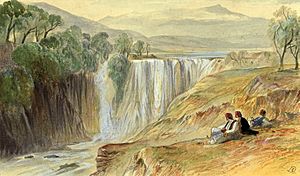
Lear's nonsense writings are special because he loved to invent words and play with sounds. He created funny words like "diaphanous doorscraper" and "blue Boss-Woss." His characters had silly names like Quangle-Wangles, Pobbles, and Jumblies. One of his most famous made-up words is "runcible spoon," which appears in "The Owl and the Pussycat" and is now in many English dictionaries:
Lear also used other tricks in his writing to surprise readers. For example, his poem "Cold Are the Crabs" starts like a serious poem but ends very suddenly and comically.
Today, limericks are usually written in five lines. However, Lear published his limericks in different ways, sometimes in two, three, or five lines, depending on how much space there was under the picture.
In Lear's limericks, the first and last lines often end with the same word, rather than just rhyming. They are usually truly nonsensical and don't have a clear punchline. They are also not rude or inappropriate, unlike some limericks today. Here's a typical Lear limerick:
There was an Old Man of Aôsta
Who possessed a large Cow, but he lost her;
But they said, "Don't you see she has run up a tree,
You invidious Old Man of Aôsta?"
Lear's poem about himself, How Pleasant to know Mr. Lear, ends with these lines, which mention his own life journey:
He reads, but he cannot speak, Spanish,
He cannot abide ginger-beer:
Ere the days of his pilgrimage vanish,
How pleasant to know Mr. Lear!
Some of Lear's limericks have even been set to music for choirs.
Works by Edward Lear
- Illustrations of the Family of Psittacidae, or Parrots (1832)
- Views in Rome and its Environs (1841)
- Gleanings from the Menagerie at Knowsley Hall (1846)
- Book of Nonsense (1846)
- Illustrated Excursions in Italy (1846)
- Mount Timohorit, Albania (1848)
- Journal of a Landscape Painter in Greece and Albania (1851)
- The falls of the Kalama Albania (1851)
- Journal of a Landscape Painter in Southern Calabria (1852)
- Poems and Songs by Alfred Tennyson (1853, 1859, 1860)
- Journal of a Landscape Painter in Corsica (1870)
- Nonsense Songs and Stories (1870, dated 1871)
- Tortoises, Terrapins, and Turtles (1872)
- More Nonsense Songs, Pictures, etc. (1872)
- Laughable Lyrics (1877)
- Nonsense Alphabets
- Argos from Mycenae (1884)
- Nonsense Botany (1888)
- Tennyson's Poems, illustrated by Lear (1889)
- Facsimile of a Nonsense Alphabet (1926)
- The Quangle-Wangle's Hat (1876)
- Edward Lear's Parrots (1949)
- The Scroobious Pip, finished by Ogden Nash (1968)
- The Dong with a Luminous Nose (1969)
- "Edward Lear: The Corfu Years" (1988)
- The 1970 cartoon Tomfoolery, based on Lear's works
Illustrations
See also
 In Spanish: Edward Lear para niños
In Spanish: Edward Lear para niños



